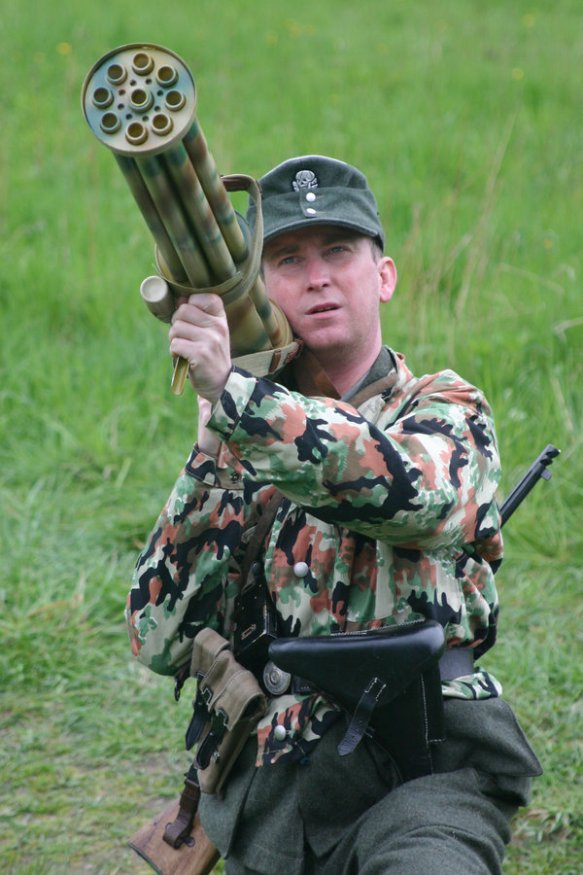‘Lufthaus B’
The Luftfaus in a transport case with preloaded ammunition cartridges. ‘Lufthaus B’
The rounds were fired in two stages with a 0.2 second gap between salvos. ‘Lufthaus B’
In 1945 the Luftfaust was designed by ‘Hugo Schneider’ of Leipzig and by the end of that year the German army were ready to field test the weapon system. The early version ‘Luftfaus A’ had only four shorter barrels however in this article we will be looking at the ‘Lufthaus B’
One thing that cannot be denied is the fact that the German military during World War II managed to develop a significant number of weapons that were precursors to many of the most impressive weapon technologies of modern warfare today. One of those weapons, the Luftfaust, was a precursor to the MANPADS, or MAN Portable Air Defense System, weapons like the Stinger, Blowpipe, or Strella. The Luftfaust, or “Air Fist”, was a recoilless shoulder-fired, rocket-propelled anti- aircraft weapon developed during the last year of the war, with large orders placed that would have marked a significant change in German weapons technologies had the war lasted another year or two. If the war had lasted into 1947, German troops would have been armed with Stg. 44’s and a variety of rocket-propelled heavy support weapons, eliminating the need for most grenades, mortars, and machine guns.
There were two versions of the Luftfaust developed. The first version was the Luftfaust-A. This weapon consisted of a bundle of four launch tubes, each capable of launching a small 2 cm diameter rocket fitted with a 90 gram projectile with a 19 gram explosive warhead. Fired in salvo, these little rockets reached a maximum velocity of 380 m/s. Unfortunately, test firings showed that while the rockets had sufficient range, they did not have sufficient dispersal inside a target kill circle to be effective against aircraft.
This lead to the Luftfaust-B, which used longer launch tubes and more of them. The Luftfaust-B mounted nine launch tubes, each 1.5 meters long, with the entire launcher assembly weighing in at 6.5 kg. When fired, the nine rounds would launch in a salvo, 0.2 seconds between each round, allowing them to form a 60 meter diameter kill pattern at a range of 500 meters, sufficient to shoot down aircraft of the day. Though heavy, the weapon produced no discernible recoil, and was fired much like a bazooka or panzerschrek, with the rear part simply laying on the shoulder.
Production of the Luftfaust-B began in March, 1945, with an order for 10,000 launch units and 4 million rocket rounds to fire through them. However, as the war concluded, only 80 were in service, being tested in combat field trials before official adoption occurred.
A weapon similar to the Luftfaust was developed as well. For ground attack aircraft, they developed the Fliegerfaust, or “Airplane Fist”. This was a hefty 6-barrelled launcher designed for mounted under the wings of aircraft. It fired six 3 cm rockets in salvo, fitted with warhead manufactured from the ammunition of the Maschinenkanone MK108, a 330 gram projectile filled with 75 grams of explosives.
While this weapon never advanced past trials, it did inspire the Hand-Fohn. This was a bundle of three launch tubes designed to fire the 7.3cm Raketen-Sprenggranate 4609, a 3.2kg rocket with a 300 gram explosive warhead, capable of attaining a speed of 360 m/s. Again, these weapon never reached the prototype stage.
All three anti-aircraft systems relied on the concept of using terminally fuzed warheads to fill a 20 to 40 meter diameter sphere with sufficient shrapnel to damage or down a plane at 500 to 600 meters range.
The Fliegerschreck
The Fliegerschreck was by the end of the war almost ready for field trials and was to use a new form of ammunition that could be used by the Panzerschreck, which enabled the Panzerschreck to be used for both the anti aircraft and anti tank roles.
The new ammunition was to contain an explosive charge and 144 small incendiary sub munitions that would be fitted to a standard rocket motor. The new warhead was ready in 1945 however none were ever issued to front line troops.
The Fliegerschreck would incorporate a new AA sighting system similar to that used by the MG 42 Machine gun
References
World War II Data Book Hitler’s Secret Weapons 1933-1945 -ISBN 1906626871
